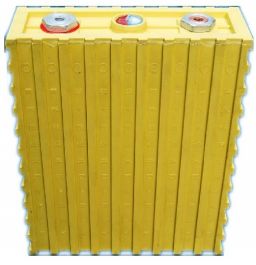sunshine_eggo
Happy Breffast!
Full disclosure: I was contacted through the forum by steve@lightning-energy.cn to review the subject battery. It was supplied to me for free. I think this is the ONE time it's ever paid me to be a post whore.
Here's the manual:
Agreed to do the review 11/21/23.
It was allegedly shipped 11/24/23.
I gotta be honest, I figured it was BS. After a couple months, I just assumed it was a fishing expedition that flopped.
Whelp... I was quite surprised when the battery arrived on 2/8/2024. I mean, I thought "WTF is this box on the porch? I didn't order anything from China!"
Lookey there!
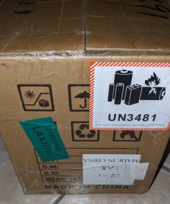
Bolts:

Well packaged:
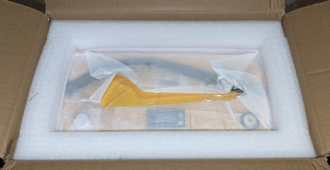
Yep. It's a battery:
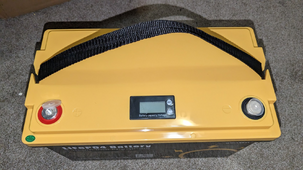
Came with a "fancy" voltmeter/SoC meter.
5.31mΩ per the YR1030. Meh, but I honestly don't know what's typical on a packaged battery.

Yep. I tried to cut it open. Found out there were screws under wee tiny yellow plugs that were nearly invisible. My 53 year old eyes aren't what they used to be...
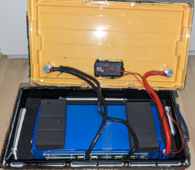
BMS:

BMS 2:
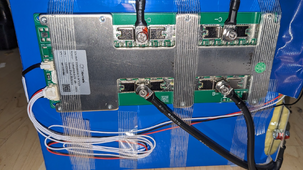
Temp sensor/pouch cells:
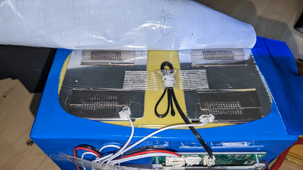
Charged @ 14.4V/10A with temp sensor in ice water, and it charged with wild abandon. NO CHARGE PROTECTION, BUT... The specs don't say it does. See towards the bottom for more commentary on low temp protection.
Discharged @20A to 10V:
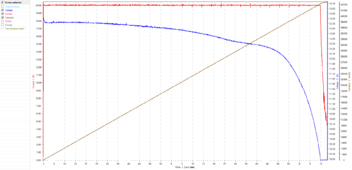
43.93Ah, so about 44% SoC - above the 30% for hazmat shipments.
Since that charge terminated normally without BMS termination and a resting voltage of 11.06, I discharged to 9V to trigger low voltage protection:
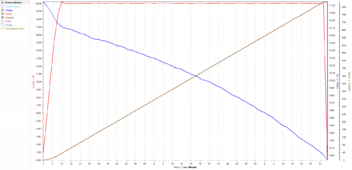
BMS triggered protection and battery showed 1.43V resting.
I set my charger to track voltage and applied the 30V/10A power supply to the battery (I do not recall the current):
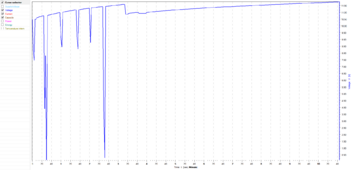
I periodically removed the power supply to see if it would hold voltage. As you can see, it didn't hold until about 4 minutes of charging.
Since I didn't want to subject my charger to an over-voltage protection event, I simply used it to log voltage while I charged with the 30V/10A supply:

Since this was at 10A, time scale is roughly equivalent to SoC/10.
I'm the first to jump into the conversation to say that almost all batteries arrive imbalanced. What really surprised me is this one... didn't. As you can see, it ran right up to just above 14.6 (14.65V per the data table) before it jumped to 15.66V (power supply setting) two seconds later. I left it there and allowed it to cycle on and off for about 1.5 hours... because... you know... free battery!
So, the conclusion is that whatever criteria the BMS is using, any cell imbalance that may be present does not impact the ability to charge to peak voltage.
I ran a 30A discharge to 10V:

105.5Ah.
Since I demonstrated the battery was balanced, I was willing to log a 20A charge to 13.6V to see how close I could get to 100%:
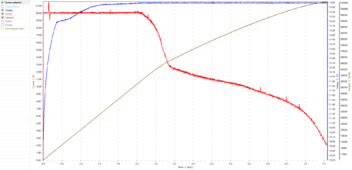
104.6Ah input or 99.7% SoC assuming 100% charge efficiency. Just needed a 5 hour absorption period and a 0.02A tail current.
Overall, aside from somewhat cheap construction (BMS just taped on), have no complaints for a $270 battery.
Now for the sticky bits...
In communication with Steve, he made the following claims:
The battery has low-temperature charging protection.
The battery can be charged at -20 ℃, and we have set the low-temperature charging protection to -10 ℃.
This is in conflict with the specification that indicates charging from 0-45°C (again, I charged without restriction with the temp sensor in ice water).
When I presented that bit from the spec, he responded with:
I have confirmed with several engineers that -10 ℃ is not harmful to battery charging. However, charging at -10 ℃~0 ℃ will be very slow.
I do not believe it, but I didn't disprove it, so we'll just let that stand as an unconfirmed claim. For best results, I recommend one provide their own low temp charge protection.
The voltage/SoC meter is a nice touch. Unfortunately, the manual is VERY poor in its description of how to program the meter. I rendered it useless inadvertently, but managed to finally get it figured out. Having a voltmeter is handy, and I'm confident that one could program the SoC parameters to their satisfaction to represent a good guess at a resting SoC.
Pros:
If I were in the market for an inexpensive 12.8V 100Ah battery without low temp charge protection, this would be on my list for consideration.
Here's the manual:
Loading…
lightning-energy.cn
Agreed to do the review 11/21/23.
It was allegedly shipped 11/24/23.
I gotta be honest, I figured it was BS. After a couple months, I just assumed it was a fishing expedition that flopped.
Whelp... I was quite surprised when the battery arrived on 2/8/2024. I mean, I thought "WTF is this box on the porch? I didn't order anything from China!"
Lookey there!

Bolts:

Well packaged:

Yep. It's a battery:

Came with a "fancy" voltmeter/SoC meter.
5.31mΩ per the YR1030. Meh, but I honestly don't know what's typical on a packaged battery.

Yep. I tried to cut it open. Found out there were screws under wee tiny yellow plugs that were nearly invisible. My 53 year old eyes aren't what they used to be...

BMS:

BMS 2:

Temp sensor/pouch cells:

Charged @ 14.4V/10A with temp sensor in ice water, and it charged with wild abandon. NO CHARGE PROTECTION, BUT... The specs don't say it does. See towards the bottom for more commentary on low temp protection.
Discharged @20A to 10V:

43.93Ah, so about 44% SoC - above the 30% for hazmat shipments.
Since that charge terminated normally without BMS termination and a resting voltage of 11.06, I discharged to 9V to trigger low voltage protection:

BMS triggered protection and battery showed 1.43V resting.
I set my charger to track voltage and applied the 30V/10A power supply to the battery (I do not recall the current):

I periodically removed the power supply to see if it would hold voltage. As you can see, it didn't hold until about 4 minutes of charging.
Since I didn't want to subject my charger to an over-voltage protection event, I simply used it to log voltage while I charged with the 30V/10A supply:

Since this was at 10A, time scale is roughly equivalent to SoC/10.
I'm the first to jump into the conversation to say that almost all batteries arrive imbalanced. What really surprised me is this one... didn't. As you can see, it ran right up to just above 14.6 (14.65V per the data table) before it jumped to 15.66V (power supply setting) two seconds later. I left it there and allowed it to cycle on and off for about 1.5 hours... because... you know... free battery!
So, the conclusion is that whatever criteria the BMS is using, any cell imbalance that may be present does not impact the ability to charge to peak voltage.
I ran a 30A discharge to 10V:

105.5Ah.
Since I demonstrated the battery was balanced, I was willing to log a 20A charge to 13.6V to see how close I could get to 100%:

104.6Ah input or 99.7% SoC assuming 100% charge efficiency. Just needed a 5 hour absorption period and a 0.02A tail current.
Overall, aside from somewhat cheap construction (BMS just taped on), have no complaints for a $270 battery.
Now for the sticky bits...
In communication with Steve, he made the following claims:
The battery has low-temperature charging protection.
The battery can be charged at -20 ℃, and we have set the low-temperature charging protection to -10 ℃.
This is in conflict with the specification that indicates charging from 0-45°C (again, I charged without restriction with the temp sensor in ice water).
When I presented that bit from the spec, he responded with:
I have confirmed with several engineers that -10 ℃ is not harmful to battery charging. However, charging at -10 ℃~0 ℃ will be very slow.
I do not believe it, but I didn't disprove it, so we'll just let that stand as an unconfirmed claim. For best results, I recommend one provide their own low temp charge protection.
The voltage/SoC meter is a nice touch. Unfortunately, the manual is VERY poor in its description of how to program the meter. I rendered it useless inadvertently, but managed to finally get it figured out. Having a voltmeter is handy, and I'm confident that one could program the SoC parameters to their satisfaction to represent a good guess at a resting SoC.
Pros:
- Well packaged.
- Bolts included
- Cells were received in balance.
- Tested > 105Ah
- Over-voltage and under-voltage protections work.
- Voltmeter/SoC gauge
- Shipping delay
- Pouch cells
- Lower quality construction, but typical of this price point - nothing overly concerning (better than older versions of this battery I've seen on YouTube)
- Unconfirmed claims of low temp charging protection at -10°C.
- Voltmeter/SoC gauge poorly documented, easy to mess up, and tricky to program.
If I were in the market for an inexpensive 12.8V 100Ah battery without low temp charge protection, this would be on my list for consideration.
Last edited:



